2018 | OriginalPaper | Buchkapitel
Modelling Complex Financial Markets Using Real-Time Human–Agent Trading Experiments
verfasst von : John Cartlidge, Dave Cliff
Erschienen in: Complex Systems Modeling and Simulation in Economics and Finance
Aktivieren Sie unsere intelligente Suche, um passende Fachinhalte oder Patente zu finden.
Wählen Sie Textabschnitte aus um mit Künstlicher Intelligenz passenden Patente zu finden. powered by
Markieren Sie Textabschnitte, um KI-gestützt weitere passende Inhalte zu finden. powered by
